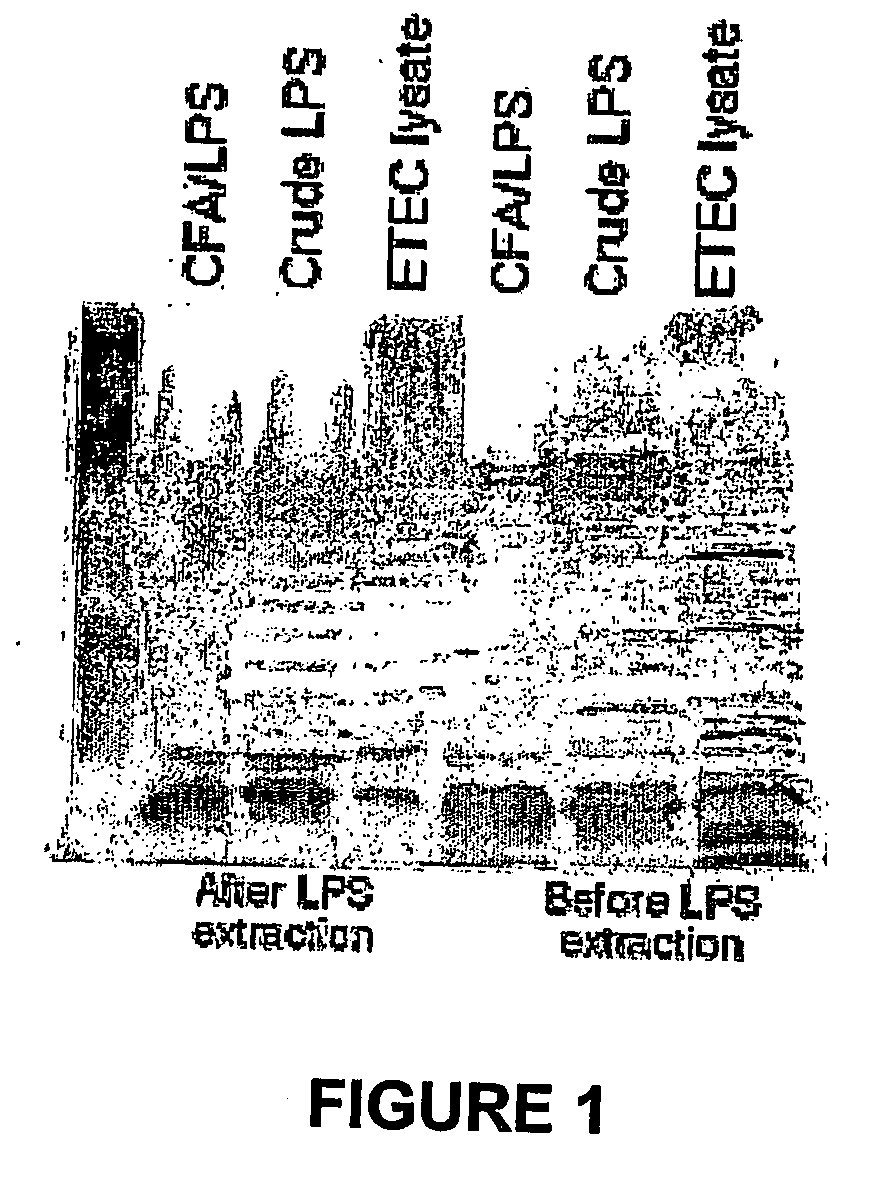Composition and method for the treatment and prevention of enteric bacterial infections
a technology for enteric bacteria and preparation, applied in the field of preparation and preparation of enteric bacteria, can solve the problems of severe constipation, reduced antibiotic therapy effectiveness, death through dehydration of young and older people, etc., and achieve the effect of improving treatment or prophylaxis of enteric diseas
- Summary
- Abstract
- Description
- Claims
- Application Information
AI Technical Summary
Benefits of technology
Problems solved by technology
Method used
Image
Examples
example 1
Manufacture of a Single Strain E.coli Vaccine
[0070] This example describes the preparation of a vaccine according to the invention in which the wall antigen is O78 and the pilus antigen is CFA1. The procedure is as follows.
Day 0
(Step A) Strain Rejuvenation
[0071] The strain to be rejuvenated is E. coli H10407 (Taurchek et al, PNAS USA 2003, 99:7066-7071). Take 2 CFA plates (Evans et al, Infect Immun 1977; 18:330-337) from the media refrigerator and place them in the biological safety cabinet. Remove the vial containing E. coli H10407 from the liquid nitrogen tank and place it in the biological safety cabinet. Open the vial and use a sterile loop to remove a small quantity of frozen material. Streak this material onto CFA plates. Place the “rejuvenation plates” in the 37° C. incubator overnight under aerobic conditions.
Day 1
(Step B) Inoculation of “Starter Suspension”
[0072] Examine each “rejuvenation plate” for pure growth. If pure growth is present proceed.
[0073] Working i...
example 2
Preparation of Hyperimmune Colostrum
[0118] The vaccine prepared according to Example 1 was used for the preparation of hyperimmune colostrum as follows.
[0119] Cows are immunised, by a registered veterinarian, with a 2 ml injection of an emulsion of the vaccine in adjuvant into the muscle tissue on the side of the neck. Up to 5 injections are given at 2 weekly intervals during months 6 to 8.5 of gestation, ceasing 1 month before parturition. Test bleeds are taken from a selection of the immunised cows and assayed to determine the level of specific antibodies. Results of these assays are used determine if a satisfactory titre has been achieved.
[0120] To limit the possibility of self-inoculation, immunisations are only made by a registered veterinarian, with assistance from experienced cattle handling personnel. During immunisation, cows are suitably restrained e.g. in a race, a crush or in a rotary milking carousel, to give clear access to the neck muscle. The injection site is cli...
example 3
Vaccine Preparation
[0122] This example describes the preparation of a vaccine according to a procedure typical of teachings of the prior art.
[0123] Bovine vaccines and the colostral antibodies against E. coli strain H10407, pilus antigens, and toxins were prepared according to the methods described below.
[0124] Preparation of colostral antibodies. The antibodies were isolated from the colostrum of dairy cows immunized with enterotoxigenic E. coli strain H10407 and a selection of pilus antigens and heat-labile enterotoxin (LT). The cows under veterinary supervision and were housed in an experimental dairy farm. See J. Husu et al (1993).
[0125] Vaccine preparation. Bacterial antigens for the production of the vaccines were prepared from the enterotoxigenic E. coi strain H10407 (078:H11 CFA / I+ ST+ LT+). Three antigens were purified from this strain: [0126] (i) formalin-inactivated suspension of whole cells (109 bacteria per ml); [0127] (ii) heat-labile enterotoxin (2 mg / ml) [0128] (...
PUM
| Property | Measurement | Unit |
|---|---|---|
| optimal temperature | aaaaa | aaaaa |
| time | aaaaa | aaaaa |
| time | aaaaa | aaaaa |
Abstract
Description
Claims
Application Information
 Login to View More
Login to View More - R&D
- Intellectual Property
- Life Sciences
- Materials
- Tech Scout
- Unparalleled Data Quality
- Higher Quality Content
- 60% Fewer Hallucinations
Browse by: Latest US Patents, China's latest patents, Technical Efficacy Thesaurus, Application Domain, Technology Topic, Popular Technical Reports.
© 2025 PatSnap. All rights reserved.Legal|Privacy policy|Modern Slavery Act Transparency Statement|Sitemap|About US| Contact US: help@patsnap.com

